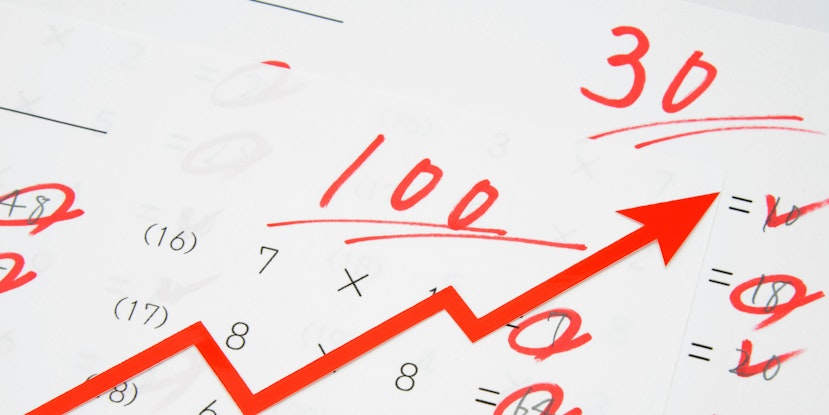How to Pass the 6th Grade Map Test in 2026
Updated November 5, 2024
- What Is the 6th Grade Map Test?
- 6th Grade MAP Test & the Common Core
- What Does the MAP Test 6th Grade Cover?
- Exam Sections & MAP Test Practice 6th Grade
empty
empty
empty
empty
empty
empty
empty
empty
empty
- How to Pass the 6th Grade MAP Test in 2026
- Tips to Ace 6th Grade MAP Test
empty
empty
empty
empty
empty
empty
empty
empty
- Frequently Asked Questions
- Final Thoughts
What Is the 6th Grade Map Test?
The 6th grade MAP Growth Test is a series of assessments that are designed to precisely measure the growth and proficiency of children based on their performance compared to their peers.
The MAP Test 6th grade is usually administered three times in the school year in the fall, the winter, and the spring, and it covers subjects that have been taught through school.
As a Measurement of Academic Progress, the assessments are available from kindergarten up to the 12th Grade.
The MAP Test grade 6 measures growth over time by looking at what students know and recognizing what they don’t know so that teachers have data points to use in structuring further learning.
Rather than some test that has been created to assess students for gifted programs, the 6th Grade MAP test reflects progress and aligns a student against their peers.
Whether they are higher, lower or about average in competency, the evidence from these tests can be used by teachers to guide and educate children, challenging them where needed.
The subject areas in the test are those that have been taught up to that grade, so nothing in the assessment should be completely unfamiliar.
The MAP test for 6th grade was created by the NWEA. In 1973, educators from Oregon and Washington formed the Northwestern Evaluation Association (NWEA).
More than 9,500 schools in the US and education agencies in 145 countries rely on the NWEA assessments to measure achievement in students.
They began creating assessment solutions that can precisely measure competency in children, with the first MAP Growth Test published in 2000.
The MAP Growth Test at all grades is based on Common Core principles, a set of learning outcomes for students that are meant to ensure that all students graduate from high school with the skills and knowledge needed to succeed.
The subjects that are covered by Common Core standards are mathematics and English language arts (literacy). These academic standards have been widely adopted throughout the United States.
The MAP testing (6th grade) is computer-based, and it is adaptive, which means that the difficulty of the future questions changes depending on whether the student answers the current question correctly.
If they get it right, then the next question will be harder, but if they get it incorrect, the next question will be easier. It is not a timed test.
For students in 6th Grade, the 2–5 MAP Growth Test is usually administered.
For those who have performed consistently higher in previous assessments; however, this is usually the time that they are introduced to the 6+ test.
The content of the 6+ test is broadly the same, but there are some subjects and related questions that are more challenging and may relate to things that have not been taught in much detail, so they need more revision.
6th Grade MAP Test & the Common Core
The 6th Grade MAP test is an assessment tool used by many schools to measure students' academic growth and proficiency in various subjects, including math and English language arts.
The test is designed to provide educators with valuable data on students' strengths and areas for improvement.
The test assesses a broad range of skills and knowledge, including those outlined in the Common Core, but it may also cover additional content.
The MAP test is often used as a diagnostic tool to identify students' individual strengths and weaknesses, and it can help inform instructional decisions and interventions.
By analyzing the results of the test, teachers can tailor their teaching to address specific areas of need and provide additional support to students who may require it.
It's important to note that while standardized tests like the MAP can provide useful information, they should not be the sole measure of a student's abilities or the effectiveness of a school's curriculum.
Educators consider multiple factors, including classroom performance, projects, assignments and other formative assessments, to gain a comprehensive understanding of a student's progress and abilities.
Overall, the 6th Grade MAP test can provide educators with valuable insights into students' academic growth and proficiency.
While it may not align directly with the Common Core State Standards, it can still contribute to the goal of ensuring students receive a well-rounded education and meet grade-level expectations.
What Does the MAP Test 6th Grade Cover?
The 6th Grade MAP Growth Test is based on up to four main academic topics, covering subjects that have already been taught.
The 6th Grade MAP Test includes math, reading and language usage, and in some cases, science. Not all schools test all grades on science knowledge.
However, it is important to know what would be on the assessment should your child be facing it.
Exam Sections & MAP Test Practice 6th Grade
In 6th grade, exams can vary depending on the school and curriculum.
Please note that this is a general overview, and your specific school or region may have different formats or additional sections.
Mathematics
This section typically covers various topics such as numbers and operations, fractions, decimals, percentages, geometry, algebraic expressions, equations and basic statistics.
Questions may involve problem-solving, calculations, and application of mathematical concepts.
Language Arts/English
This section assesses your skills in reading comprehension, grammar, vocabulary, spelling and writing.
Your child may encounter passages to read and answer questions, grammar and vocabulary exercises and prompts for short written responses.
Science
The science section examines your understanding of scientific concepts, processes and principles.
It may cover topics like the scientific method, ecosystems, energy, matter, cells, genetics, Earth science and physical science.
Questions can be in multiple-choice, fill-in-the-blank or short answer format.
Social Studies
This section focuses on history, geography, civics and culture.
Your child might be tested on topics like ancient civilizations, world history, U.S. history, map skills, government systems, economics and current events.
Questions may involve multiple-choice, matching or short answer formats.
Foreign Language (if applicable)
If your child is studying a foreign language, there might be a section to assess your vocabulary, grammar, reading and listening skills in that language.
Practice the 6th Grade Map Growth Test with Test Prep Online
6th Grade Map Math
There are several different areas of mathematical knowledge that are tested in the 6th Grade MAP Test that include:
Operations and Algebraic Thinking
This covers patterns in a series of numbers, understanding numerical expressions, and confident use and understanding of all four operators (addition, subtraction, division and multiplication).
Numbers and Operations
This deals with the understanding and application of decimals and fractions and confidently handling operations using multi-digit numbers.
Geometry
From solving problems using 3D shapes to analyzing and understanding graphs, the geometry questions are looking for the ability to make reasoned decisions based on shapes.
Measurement and Data
Taking data and using it to solve problems means understanding relative concepts, and for measurement, students need to be confident about length, area, volume and angles.
Solve the equation: 3(x + 4) = 21
a) x = 7
b) x = 5
c) x = 3
d) x = 9
6th Grade Map Reading
This section of the MAP test 6th grade is not just about being able to read but also about levels of comprehension. The specific areas of testing include:
Literature
Reading literature pieces and recognizing themes, structure and point of view. Analysis of the passage and extricating meaning.
Informational Texts
These questions are looking for the student to be able to recognize subjectivity and perspective as well as the purpose of the text and the argument that it is making.
Word Meaning and Vocabulary Knowledge
The MAP testing 6th grade is not just about a wide vocabulary. It is also about recognizing words through context and by their relationship with other words.
6th Grade Map Language Usage
Fluency and confidence in English, especially in written work, is the theme of these questions. Specific areas of knowledge that are tested in the 6th Grade MAP Test include:
Writing
The order of a good writing structure, including researching, revising ideas, developing themes and the act of writing itself
Understand and Edit Mechanics
In these questions, the student is being assessed on their understanding of basic rules like capitalization and punctuation, as well as spelling.
Grammar and Usage
Grammar conventions and how they apply to written work is an important part of literacy, which is what is tested in this part of the assessment.
Choose the correct verb form to complete the sentence:
The students ____________ studying for their upcoming test.
a) is
b) am
c) are
d) be
6th Grade Map Science
This is the section that is not always administered at every grade or even in every school. It is still worth noting what would be covered, just in case your school does use it.
We also recommend sourcing science MAP test practice 6th grade online, to get a better understanding of what to expect.
Life Science
Focuses on organisms and molecules, evolution, and ecosystems.
Physical Science
This section looks at the interaction of matter, including forces and energy.
Earth and Space Science
For this part of the assessment, the focus is on the Earth and our relative position in space, including the water system and the impact of human life.
Which of the following is an example of a renewable resource?
a) Coal
b) Natural gas
c) Solar energy
d) Petroleum
If you want 12-month access to all the practice resources for this test, our partner TestPrep-Online.com offers a Family Membership.
Family Membership gives you access to all the TestPrep-Online resources for the next 12 months. You will also get two separate accounts, which can be very helpful if you have two children preparing for their tests.
Get a Family Membership with 12-month access

How to Pass the 6th Grade MAP Test in 2026
Step 1. Read
Reading widely and encouraging reading of different styles of texts will give your child access to new vocabulary, styles, and subjects.
Both fiction and non-fiction, look for challenging reads that will help your child to make the most of their current knowledge and discover new things.
Active reading in all areas makes sure that your child is looking for things like meaning, structure and argument, as well as helping them to identify stylistic cues.
Step 2. Make a Vocabulary Book
Whilst encouraging reading, find a notebook that can be used to note down unfamiliar words. This can be added to throughout the year.
To make the most of this resource, make sure that the word is spelled correctly and is completed with the definition so that it can easily be revised.
You can then use word association games, find antonyms and synonyms and use these new words in everyday talking and writing to help.
Step 3. Practice Math at Home and as Part of Daily Life
Familiarity with completing math questions will help make them seem less scary, so help your child complete math problems as part of daily life.
This might include simple adding (for example, for a shopping bill) or something a little more complicated (working out the tax on a purchase).
The idea is that the more a child completes these questions, the easier they will find doing it in the test, thus improving their 6th grade math MAP test scores.
Step 4. Have a Game Plan
Some questions, especially in the math section, will be easier for your child to answer if they know the techniques.
Creating a game plan for answering each type of question, whether that is a multiplication method or how to do calculations using fractions, means that in theory, any question of that kind can be answered.
It is important, however, that your student knows why that technique works so they can confidently apply it to unfamiliar problems.
Step 5. Revise and Understand the Writing Process
Part of the language usage MAP test is to understand how writing should work and the full process that should be used to create a successful piece of written work.
As this routine applies to both fiction and non-fiction writing, ensure that any written work your child produces follows the process:
- Pre-drafting
- Drafting
- Revising
- Publishing
Step 6. Practice Recognizing the Structure of Text
Identifying the way a piece of text is written will help your child to feel confident answering questions about the structure.
When reading with your child or looking at the way a piece of information is put together, check that they can recognize paragraphs, subsections, titles and subheadings quickly and accurately.
Step 7. NWEA Practice Tests 6th Grade
Taking practice tests helps to get your child in the right mindset for answering questions under pressure, and there are a number of NWEA practice tests for 6th grade available online that can be used to do this.
It is important that these are taken under exam conditions, so make sure that your student takes them somewhere quiet where they won’t be disturbed, and let them get on with it without offering help.
You might want to introduce a timer to the practice. Although the real test isn’t timed, having some time pressure will help your child to focus on the task at hand rather than being distracted.
Step 8. Prioritise Healthy Habits
Students perform better when they are well-rested, well-fed and well hydrated.
You can help your child achieve more by emphasizing the importance of making healthy choices like getting an early night, eating vegetables and drinking plenty of water.
Exercise is also important to good performance, so encourage participation in sports, dancing or even just going for a walk during the revision process.
Step 9. Make Learning Fun
There are several ways that you can incorporate revision and learning into games, you can play board games like Scrabble, word-play association games that encourage the use of synonyms and antonyms, and reward reading and learning.
Even games like Monopoly, where math is needed to calculate funds needed to buy houses and hotels, is a (sometimes) fun way to encourage revision.
Practice the 6th Grade Map Growth Test with Test Prep Online
Tips to Ace 6th Grade MAP Test
Here are some tips to help you prepare for and perform well on the 6th Grade MAP Test:
Familiarize your child with the MAP test format
Understand the structure of the test, including the types of questions, time limits, and any specific instructions.
This will help your child feel more confident and comfortable during the test.
Review the relevant content
The MAP Test assesses various subjects, such as math and English language arts.
Review the class notes with your child, textbooks, and any study guides provided by their teacher to reinforce key concepts and skills.
Focus on areas where they feel less confident and seek clarification from their teacher if needed.
Practice time management
The MAP Test is typically timed, so it's important to practice managing your time effectively.
Take practice tests or work on sample questions with a timer to improve your child's pacing and ensure they complete all sections within the given time frame.
Improve your reading comprehension
The English language arts section of the test often includes passages and questions that require strong reading comprehension skills.
Practice reading different types of texts and answering questions about main ideas, supporting details, vocabulary and inference.
Develop math problem-solving strategies
For the math section, practice solving a variety of problems, including word problems.
Focus on understanding the problem, identifying relevant information, and selecting appropriate problem-solving strategies.
Work on mental math techniques and practice using calculators if allowed during the test.
Pay attention to details
Read and analyze each question carefully before answering.
Pay attention to any specific instructions, keywords or key phrases that may help you choose the correct answer.
Avoid rushing and take the time to review your answers before moving on to the next question.
Stay positive and manage test anxiety
It's normal to feel some test anxiety, but try to stay positive and confident in your abilities.
Practice relaxation techniques, such as deep breathing, to help calm your child's nerves.
Remember that the MAP Test is just one measure of your abilities and that your hard work throughout the year also contributes to your overall academic growth.
Seek help and support
If they're struggling with certain topics or concepts, don't hesitate to seek help from a teacher, classmates or even online resources.
Collaborating with others and asking for clarification can enhance your understanding and performance.
MAP testing is used in the 6th grade and runs up to 12th grade.
As the grades increase, the material and questions get harder. A 6th grader will be questioned on the material they have learned in school.
The purpose of the MAP test is to examine a student’s academic progress and what they need to improve upon.
At 6th grade, you should be comfortable with number functions and basic algebraic equations. You should also be able to interpret mathematic data to calculate probability and percentiles. The use of integers is also cited as what a 6th grader should know.
For the best MAP practice test 6th grade resources, you can try searching online on educational websites and test preparation platforms.
Look for reputable sources that offer MAP test practice 6th grade, like testprep-online.com.
These resources often provide comprehensive practice materials aligned with the test content and format, helping students become familiar with the types of questions they may encounter.
It's advisable to choose resources that have positive user reviews and a track record of providing quality educational materials.
The answer key for the 6th grade MAP test is typically not publicly available as it is meant to be used by educators for assessing student performance.
To obtain the answer key, you can try reaching out to the organization or institution that administered the MAP test 6th grade.
They may provide the answer key upon request, especially if you are a parent or guardian of a student who took the test.
Additionally, some educational websites and platforms may offer NWEA practice tests 6th grade that include answer keys for self-assessment purposes.
Final Thoughts
The 6th Grade MAP Test is an important benchmark in your child’s development as they are looking towards their next stage of education.
Teachers use it to ensure that your student is reaching the expected standards and to plan where extra help and tuition might be needed in accordance with the Common Core standards, so it’s not considered a ‘pass/fail’ test.
For parents with children facing the MAP Growth Test, the best thing that you can do is support them in making learning a normal and natural part of everyday life.
Because the exam questions are based on subjects and principles they've previously been taught, the support you give should be focused on helping them remember and revise.
6th grade MAP test practice, encouragement and support are the best ways you can help your child as they approach their test.





